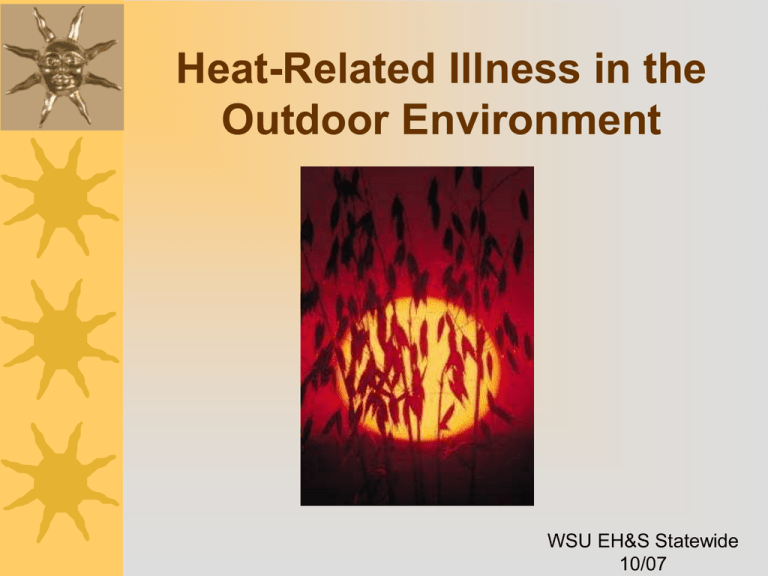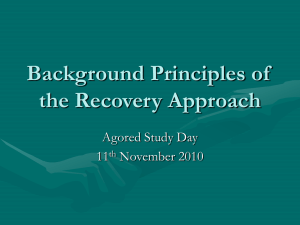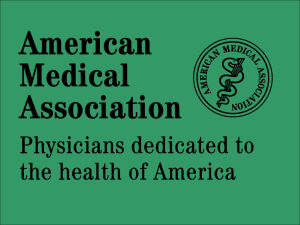Heat Stress (ppt) - Washington State University at Spokane
advertisement

Heat-Related Illness in the Outdoor Environment WSU EH&S Statewide 10/07 Heat-Related Illness Why is it important to know about heat illness? Heat illness can effect anyone Heat illness is dangerous Heat illness can kill Heat illness is preventable EH&S Statewide 10/07 Presentation Outline What is a heat-related illness Types of heat-related illness EH&S Statewide 10/07 Signs & symptoms Contributing risk-factors Prevention Emergency response procedures Heat-Related Illness Heat stress is the buildup in the body of heat generated by the muscles during work, plus heat coming from warm and hot environments. When the body becomes overheated, less blood goes to the active muscles, the brain and other internal organs. Workers get weaker, become tired sooner, may be less alert, and less EH&S Statewide 10/07 able to use good judgment. As the stress from heat becomes more severe, there can be a rapid rise in body temperature and heart rate. Heat exhaustion and heat stroke result when the body is subjected to more heat than it can cope with, causing decreased mental performance, organ damage, convulsions, and death. During hot weather, heat-illness can be the underlying cause of other injuries, such as heart attacks on-the-job, falls, and equipment accidents arising from poor judgment. Types of Heat-Related Illnesses Heat Rash EH&S Statewide 10/07 Heat Cramps Heat Fatigue Heat Exhaustion Heat Stroke Heat Rash What to look for: Red blister-like eruptions Itching or prickling EH&S Statewide 10/07 What to do: Get out of the sun to somewhere cool Keep skin dry Monitor for infection Consult physician Heat Cramps A heat cramp is an involuntarily and forcibly contracted muscle or fibers of a muscle that don’t relax (i.e., a muscle spasm that doesn’t relax). Heat cramps usually occur in the arm, leg or stomach muscles, and are very painful. Heat cramps can last a few seconds, 15 minutes, or more, and can occur multiple times, and without warning. EH&S Statewide 10/07 Heat Cramps are Painful! Pain from heat cramps distract a worker, and may create serious consequences. EH&S Statewide 10/07 A person’s automatic reaction is to bend over in pain, fall down in pain, or reach for area in pain without thought of the result of moving quickly. This can be dangerous, if a person is operating machinery, driving, on a roof, etc. when a heat cramp occurs; a serious accident may result. Treatment of Heat Cramps Get out of the heat to a cool place. Rest! Drink electrolyte-containing fluids. EH&S Statewide 10/07 Gently stretch the cramped muscle and hold the stretch for ~ 20 seconds, then gently massage the muscle. Repeat if necessary. Don’t return to work in the heat this day. Heat Fatigue Heat Fatigue signals a person is in trouble, and potentially headed towards heat exhaustion. What to look for: EH&S Statewide 10/07 Impaired mental or sensorimotor performance Fainting What to do: ASAP: Stop work, get out of the heat, drink fluids, and seek medical aid before heat fatigue progresses to heat exhaustion. Heat Exhaustion Heat exhaustion is a more serious and advanced stage of heat-related illness than heat fatigue. EH&S Statewide 10/07 Beware! Untreated heat exhaustion can quickly progress to heat stroke. Danger! EH&S Statewide 10/07 Heat Fatigue & Dehydration Heat Exhaustion Heat Stroke Heat Stroke Can Be Fatal! Heat Stroke IS A MEDICAL EMERGENCY EH&S Statewide 10/07 The body becomes so stressed that it can no longer regulate its on own temperature & it overheats. Potentially, when the body can’t cool itself, body temp can reach 106° in 10-15 minutes. The body literally cooks itself. Prevent Heat-Related Illness To prevent injury, learn to recognize the signs and symptoms of heat exhaustion and heat stroke.EH&S Statewide 10/07 Signs & Symptoms Heat Exhaustion & Heat Stroke Both heat exhaustion and stroke may exhibit: Red Face Mood changes, irritability, agitation, or confusion EH&S Statewide 10/07 Nausea/Vomiting Unsteady gait Fainting Erratic behavior Rapid pulse Fatigue and weakness Dizzy or light-headed Knowing the Difference Can Save a Life! HEAT EXHAUSTION Extreme sweating or pale, clammy skin Normal to slightly elevated temperature HEAT STROKE Hot, dry skin/face that is flushed, but not sweating EH&S Statewide 10/07 High temperature (>104° F) Only in Heat Stroke Chills/Shivering Convulsions and/or seizures Loss of consciousness Coma May resemble a heart attack Heat Exhaustion and Heat Stroke EH&S Statewide 10/07 Stop work, get out of the heat, drink electrolyte-containing fluids, and seek medical aid How The Body Stays Cool! The body’s thermostat is the Hypothalamus gland, which is located in the brain, and controls body heat. The hypothalamus signals blood to flow toStatewide 10/07 EH&S surface of the skin to cool itself. The body sweats. Sweat evaporates off skin and has a cooling effect on the blood and thus the body. Many things can interfere with the body’s cooling processes or contribute to body heat production. Contributing Factors to Heat-Related Illness Heat + Humidity + Other (Internal & External) Factors = Total Heat Burden on the Body EH&S Statewide 10/07 Humidity and Heat Inhibit Body Cooling Humidity (moisture in the air) interferesEH&S with Statewide 10/07 sweat evaporating from the skin thus interferes with the cooling of the body. The more humid it is, the less sweat can evaporate, and the less body cooling occurs, and the more chance of heat-related illness The hotter the temperature, the harder the body has to work to produce enough sweat to stay cool. Heat and humidity together greatly increase the potential for heat-related illness. Monitor Heat and Humidity To help keep the body’s cooling mechanisms working properly, it is important to monitor heat and humidity values throughout each workday in hot and/or humid weather, and EH&S adjust tasks10/07 Statewide accordingly. Heat Index Used to Monitor Heat + Humidity Heat + humidity values = Heat Index The higher the temperature and humidity the higher the Heat Index. Statewide 10/07 The Heat Index gives an “Apparent” EH&S Temperature. The Apparent Temperature is a higher value than temperature alone as it factors in humidity. Monitor the Heat Index online and/or by using a Heat Index Chart (see next slide). Heat Index Chart Heat + Humidity = Heat Index EH&S Statewide 10/07 Implement controls at 90° or before May feel effects at 80° Source: National Oceanic and Atmospheric Administration Heat Index Warnings Heat + Humidity = Heat Index Heat Index Extreme Danger 130 or higher Implement controls at 90° or before May feel effects at 80° General Effect of Heat + Humidity with Prolonged Exposure & Physical Activity Heat stroke highly likely EH&S Statewide 10/07 Danger 105-129 Heat stroke, heat cramps, and heat exhaustion likely, and heat stroke possible Extreme Caution 90-104 Heat stroke, heat cramps, and heat exhaustion possible Caution 80-89 Fatigue possible Other Risk Factors Heat + Humidity + Other Factors = Total Heat Burden Learn to recognize risk factors and how to mitigate them to avoid EH&SheatStatewide 10/07 related illness. Risk Factors: Direct Sun The more direct sun, the hotter the environment. Shield yourself or stay out of the direct sun as much as possible. EH&S Statewide 10/07 Sunlight is at its peak between 10AM-2PM daily; a good time to stay out of the sun. Risk Factors: Radiant Heat Radiant heat is the transfer of heat energy through the air from sun and other sources such as, asphalt, engines, and dark surfaces. EH&S Statewide 10/07 Radiant heat can add 15° to Heat Index Risk Factors: Conductive Heat Conductive heat transfers heat to worker by direct contact with heat sources such as tools, equipment, and machinery. EH&S Statewide 10/07 Risk Factors: Limited Air Movement Limited air movement, such when there is little or no wind, creates a hotter environment as the less the air moves, the less cooling of the body can occur. EH&S Statewide 10/07 For example, there is limited air movement while working in a trench, a partially enclosed area, vehicle cab, or on the leeward side of a structure. Risk Factors: Physical Exertion The harder and longer you work, the hotter you become. Physical exertion increasesEH&S the Statewide chance 10/07 of dehydration. Risk Factors: Protective Clothing Wearing PPE such as non-breathable spray suits, gloves, boots, rain gear or respirators can hold heat to the body EH&S Statewide 10/07 and inhibit cooling. Risk Factors: Personal Age: the young and over-50 are more susceptible to heat-related illness Poor fitness: use more physical exertion and energy to do a job Over-weight: the body holds heat more easily and is stressed by extra weight EH&S Statewide 10/07 Risk Factors: Certain Medications Some medications can make a person more sensitive to the effects of heat and many contribute to body dehydration; examples are: Allergy medicines (antihistamines) Cough/cold medicines Blood pressure/heart medicines Irritable bladder/bowel medicines Laxatives Mental health medicines Seizure medicines Thyroid pills Water pills (diuretics) EH&S Statewide 10/07 Consult health care provider or pharmacist for information Risk Factors: Medical Conditions or Illnesses Heart conditions, diabetes, high blood pressure, etc. EH&S Statewide 10/07 Illness or fever Hangover Risk Factors: DIET MATTERS! Before working in the heat: No heavy foods Harder to digest & increases metabolic heat No alcohol or sugary drinks Dehydrate the body No caffeinated drinks Diuretic No carbonated drinks • Gas bubbles limit fluid intake No nicotine Constricts blood vessels EH&S Statewide 10/07 Risk Factors: Attitude Ditch that “Macho” Attitude! EH&S Statewide 10/07 Slow down, pace yourself, and take breaks, especially on hot days! Risk Factors: Attitude Type-A’s: Slow the Pace to Keep from Over-Heating! EH&S Statewide 10/07 Slow down, pace yourself, and take breaks on hot days! Risk Factors: Attitude Don’t Be a Super-Hero! These actions lead to dehydration and heat stress: “I’m tough ~ I don’t need a water break” EH&S Statewide 10/07 “I’m not thirsty ~ I don’t need to drink” “I’ll lose pay, if I take a water break” “I’ll be letting my team down, if I take a break” “I’m new here ~ I need to prove myself” Heat Illness Regulations An average of 500 people die each year in the United States by effects from heat (EPA) EH&S Statewide 10/07 In 2007, the State of Washington put in place regulations to address heat related illness: WAC 296-62-095 Heat Illness Regulations WAC 296-62-095 Requires: Employers with one or more employees performing work in an outdoor environment to implement workplace practices designed to reduce or EH&S Statewide 10/07 eliminate risk of heat-related illness. Practices must be in writing, and must include: Accessibility to drinking water in sufficient quantity to provide at least one quart per employee per hour Procedures to remove employees experiencing signs and symptoms of heat-related illness from duty, to provide sufficient means to reduce body temperature, and to determine if medical attention is needed Employee training must be provided initially and annually. Preventing Heat-Related Illness Supervisors prevent heat-related illness by: Monitoring the work-day weather & heat index EH&S Statewide 10/07 Scheduling tasks to minimize physical exertion Advising employees to pace themselves Encouraging frequent breaks on hot days Providing radio, pager, or cell phone to keep in contact with base and each other Rotating job tasks Preventing Heat-Related Illness Supervisors prevent heat-related illness : By providing annual heat-related illness awareness training EH&S Statewide 10/07 By providing CPR and First Aid training By providing easy access to water via water bottles, coolers, hydration packs, and transportation to base water supply Preventing Heat-Related Illness Supervisors prevent heat-related illness by: Providing appropriate PPE Cooling vests & bandanas Hats UVA/UVB rated sun glasses EH&S Statewide 10/07 Providing sun screen (SPF 15 or greater & UVA/UVB effective) Work Smart Learn how to Keep Cool! EH&S Statewide 10/07 Preventing Heat-Related Illness Work Smart Clothing traps body heat and inhibits perspiration Especially: Personal protective equipment (PPE)EH&S Statewide 10/07 Heavy clothing Multiple clothing layers Dark-colored clothing absorbs heat Stay Cool! Remove PPE & excess clothing during breaks Preventing Heat-Related Illness Work Smart Wear appropriate clothing: Light-colored Light-weight EH&S Statewide 10/07 Natural fibers Hat with a brim Cooling vest or bandanas may be helpful in some cases Apply appropriate sunscreen to exposed skin Preventing Heat-Related Illness Work Smart: Acclimatize Acclimatization is Extremely Important! People can collapse, become easily fatigued, make EH&SheatStatewide 10/07 mistakes, get into accidents, or develop related illnesses, if not properly acclimatized Many of us travel across the state, nation, or over seas for our work Take special care, if you are used to a cooler climate and are going to a hot/humid climate Go Prepared! Preventing Heat-Related Illness Work Smart: Acclimatize Plan in extra time (several days) to adjust to hot working conditions Gradually build up exposure time, and adjust work routines, to increase heat EH&S Statewide 10/07 tolerance Preventing Heat-Related Illness Work Smart: Acclimatize Supervisors and co-workers pay special attention to employees that are: New EH&S Statewide 10/07 Just returning from work from being sick Are absent for more than 2 weeks Just moved from a cooler climate During heat-wave events Preventing Heat-Related Illness Work Smart: Physical Exertion Produces Internal Heat in the Body Consider: What kind of work will be performed? How hard is the work? EH&S Statewide 10/07 How long is the work task/period? Photo credit: http://www.sullys.com.au/LawnMowing.htm Preventing Heat-Related Illness Work Smart Alternate heavy work with light work Schedule the hardest work for cooler parts of the day EH&S Statewide 10/07 Pace yourself Work in the shade or out of direct sun Increase frequency of breaks when: Conditions are very hot Work requires high exertion levels Protective clothing limits evaporative cooling Preventing Heat-Related Illness Work Smart: Stay Hydrated Proper hydration is key to preventing heat illness When dehydrated the amount of sweat that can be produced decreases, and the body can’t cool itself EH&S Statewide 10/07 Drink water throughout the day to replace body fluid lost by sweating Do not wait for thirst before drinking water It is also important to incorporate electrolytecontaining drinks in your daily fluid intake Drink 8-16 ounces of water before work to pre-hydrate Preventing Heat-Related Illness Work Smart: Stay Hydrated Drink 1 quart or more of water over the course of an hour when the work environment is hot, and a person sweats more than usual EH&S Statewide 10/07 This is to replace the 2 quarts of sweat per hour the body can produce in hot environments ~1 cup every 15 minutes Persons who are on restricted fluids, or with medical conditions that heat or bright light effect consult a physician before working in the heat Preventing Heat-Related Illness Work Smart: Stay Hydrated Drinking water sources: Be closeable & have a tap Clearly marked Suitably cool Individual cups provided Bottled water Hydration packs called camelbacks -users sip water through a tube Hydration pack EH&S Statewide 10/07 Photo credit: UC Davis Worker wearing hydration pack Preventing Heat-Related Illness Work Smart ESTABLISH A BUDDY SYSTEM! Keep an on co-workers for symptoms of heat illness such as crankinessEH&S and Statewide denial 10/07 Having Trouble in the Heat? All Activity If you become: Light-headed Weak Have a pounding heart Confused Faint EH&S Statewide 10/07 Trouble breathing Notify Supervisor Take a Break and Rest In a cool place Drink fluids Loosen or shed unnecessary clothing Lie down If a Co-Worker Is Having Trouble in the Heat Transport the person to base, or to a cooler, shaded area so the person can rest and lay down. Get help on the way: call 911, or have base call 911, and then alert the supervisor. Do not leave person alone! Loosen and remove heavy clothing that restricts evaporation EH&S Statewide 10/07 and cooling. If person is alert and not nauseated, provide fluids such as cool water, juice, sports drinks, or non-caffeinated soft drinks. Fan the person, spray or mist with cool water, apply wet cloth to skin. Do not further expose the person to heat any more that day. Get Help on the Way! Call 911! EH&S Statewide 10/07 Call when a person does not feel better in about 15 minutes. Call sooner if they show any signs of heat stroke! SECONDS COUNT! If You Suspect Heat Stroke WHILE WAITING FOR MEDICAL HELP TO ARRIVE Cool the person using whatever methods available Apply ice packs under arms & to the groin area Place the person in a cool shower EH&S Statewide 10/07 Spray them with cool water from a hose Sponge the person with cool water If the humidity is low, wrap person in a cool wet sheet and fan them vigorously Immerse the person in a tub of cool water Do not try to give unconscious persons fluids to drink. If You Suspect Heat Stroke If emergency 911 medical personnel are delayed, call the hospital emergency room for further instruction EH&S Statewide 10/07 In Summary: Work Smart! Know the signs and symptoms of heat related illnesses and take them seriously Stay hydrated - Drink water/fluids frequently EH&S Statewide 10/07 Consider sports drinks when sweating a lot Monitor Heat Index Avoid alcohol, caffeinated drinks, and heavy meals before or during work Photo credit: www.csao.org In Summary: Work Smart! Plan work tasks for heat relief Pace yourself EH&S Statewide 10/07 Acclimatize Wear appropriate clothing Keep an eye on your buddy Take breaks Stay Cool! EH&S Statewide 10/07 Proceed to quiz






